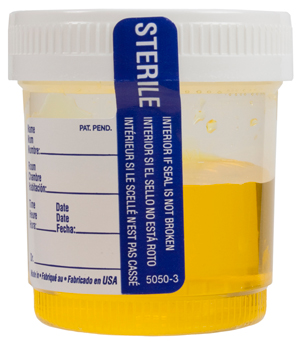Your physician ordered a urinalysis to be done. You collected your urine specimen and sent it to the laboratory. The results showed that you have white blood cells (WBCs) in the urinalysis report and you wondered what that could be. A little knowledge on this diagnostic procedure won’t hurt a bit. Knowledge is power.
What is Urinalysis?
 Urinalysis is a diagnostic tool used to detect substances or cellular material in the urine associated with different metabolic and kidney diseases. It gives a fast general overview about a person’s health status. It is a routine examination that is ordered widely to detect any disease or abnormalities that may require follow up care. It is used as an initial diagnostic tool for patients who complain of problems in urinary system. It is a widely used routine examination used for people who have fever but with no other symptoms such as cough and cold or other tissue trauma. In recruitment departments of companies and offices, it is one of the routine examinations requested along with chest x-ray and blood chemistry to know if a person is fit to be hired. When admitted to an institution, it is one of the first few examinations that need to be done after physical examination. It is a rapid method to know about the function of the organs of a person because kidney plays a huge role in the whole body. Urinary tract infections are detected easily with urinalysis by the analysis of the number of white blood cell count in the urine sample.
Urinalysis is a diagnostic tool used to detect substances or cellular material in the urine associated with different metabolic and kidney diseases. It gives a fast general overview about a person’s health status. It is a routine examination that is ordered widely to detect any disease or abnormalities that may require follow up care. It is used as an initial diagnostic tool for patients who complain of problems in urinary system. It is a widely used routine examination used for people who have fever but with no other symptoms such as cough and cold or other tissue trauma. In recruitment departments of companies and offices, it is one of the routine examinations requested along with chest x-ray and blood chemistry to know if a person is fit to be hired. When admitted to an institution, it is one of the first few examinations that need to be done after physical examination. It is a rapid method to know about the function of the organs of a person because kidney plays a huge role in the whole body. Urinary tract infections are detected easily with urinalysis by the analysis of the number of white blood cell count in the urine sample.
When is it ordered?
 Urinalysis is often requested by a physician for complaints of fever, abdominal pain, bladder distention, back pain, blood in urine and urethral discharges. It is also ordered to evaluate drug therapy’s efficacy.
Urinalysis is often requested by a physician for complaints of fever, abdominal pain, bladder distention, back pain, blood in urine and urethral discharges. It is also ordered to evaluate drug therapy’s efficacy.
Specimen Collection for Urinalysis
 An acceptable way for collecting urine specimen for urinalysis is the “Midstream Clean Collection,†which prevents the specimen from being overly contaminated with the environment. For those who have indwelling foley catheters, it is always best not to disconnect anywhere from the continuity of the tubings to avoid infections and to avoid the specimen from being contaminated. A syringe is used and urine specimen is drawed using the third injection port that is used for extraction of urine. For those who are to be inserted with straight catheters, as in those who have bladder distention and needs someone to intermittently collect and measure their urine output more accurately. It is always best to collect the specimen in an aseptic manner to avoid contamination or infection.
An acceptable way for collecting urine specimen for urinalysis is the “Midstream Clean Collection,†which prevents the specimen from being overly contaminated with the environment. For those who have indwelling foley catheters, it is always best not to disconnect anywhere from the continuity of the tubings to avoid infections and to avoid the specimen from being contaminated. A syringe is used and urine specimen is drawed using the third injection port that is used for extraction of urine. For those who are to be inserted with straight catheters, as in those who have bladder distention and needs someone to intermittently collect and measure their urine output more accurately. It is always best to collect the specimen in an aseptic manner to avoid contamination or infection.
Urinalysis Results
The requesting physician should correlate the results of the urinalysis with the assessment findings that he has done, comparing the signs and symptoms with the results. The urine specimen should be interpreted within 2 hours after collection for a more accurate result. A normal urinalysis doesn’t always indicate that there is no problem or disease since some deviations from the normal values may happen in a later time so a routine urinalysis most of the time still requires follow-up or repeat in specimen collection and analysis.
 A complete urinalysis includes physical, chemical, and microscopic examinations. The urine specific gravity allows the determination of the person’s hydration status. Cloudy urine can be indicative of pus formation and increased white blood cell count but can also be the case of presence of precipitated phosphate crystals in alkaline urine. The odor and color of urine is also evaluated. A foul odor can be indicative of urine concentration or presence of an infection. More diluted urine due to drinking plenty of water can be more colorless in color. The normal color of urine is light yellow to amber. Hematuria or the presence of red blood cells in the urine can be indicative of slight or hemorrhagic bleeding. Minimal amounts of red blood cells are okay but huge amounts needs immediate action. Uncomplicated urinary tract infections can be treated with antibiotics if nitrites and white blood cell count is high. If infection is non reactive to the symptomatic treatment of antibiotics, a further more reliable test, urine gram stain with culture and sensitivity is needed for further analysis. In gram staining, the specific infectious agent is identified. Culture and sensitivity tests are done to know what best antibiotic to use.
A complete urinalysis includes physical, chemical, and microscopic examinations. The urine specific gravity allows the determination of the person’s hydration status. Cloudy urine can be indicative of pus formation and increased white blood cell count but can also be the case of presence of precipitated phosphate crystals in alkaline urine. The odor and color of urine is also evaluated. A foul odor can be indicative of urine concentration or presence of an infection. More diluted urine due to drinking plenty of water can be more colorless in color. The normal color of urine is light yellow to amber. Hematuria or the presence of red blood cells in the urine can be indicative of slight or hemorrhagic bleeding. Minimal amounts of red blood cells are okay but huge amounts needs immediate action. Uncomplicated urinary tract infections can be treated with antibiotics if nitrites and white blood cell count is high. If infection is non reactive to the symptomatic treatment of antibiotics, a further more reliable test, urine gram stain with culture and sensitivity is needed for further analysis. In gram staining, the specific infectious agent is identified. Culture and sensitivity tests are done to know what best antibiotic to use.
Why White Blood Cells in Urine?
 White blood cells are activated once the urinary tract has high counts of bacteria. Some white blood cells eat up the infectious matter in the urinary tract and some activate the immune system for protection. An increase in white blood cell count is due to pus formation as result of fighting an infectious agent. It is also an indication that there is presence of infection.
White blood cells are activated once the urinary tract has high counts of bacteria. Some white blood cells eat up the infectious matter in the urinary tract and some activate the immune system for protection. An increase in white blood cell count is due to pus formation as result of fighting an infectious agent. It is also an indication that there is presence of infection.
Normal Reference Values in Urinalysis
Specific gravity |
1.002-1.030 |
|
pH |
5-7 |
|
Protein |
negative-trace |
|
Glucose |
negative |
|
Ketone |
negative |
|
Bilirubin |
negative |
|
Blood |
negative |
|
Nitrite |
negative |
|
Leukocyte |
negative |
|
Urobilinogen |
0.2-1.0 Ehr U/dL |
|
Micro |
||
RBCs |
          0-2/HPF |
|
WBCs |
          0-2/HPF |
|
RBC casts |
0/HPF |
